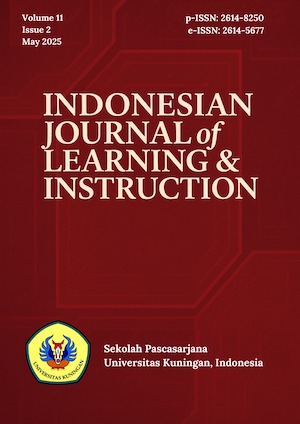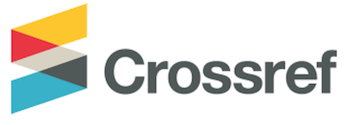THE ANALYSIS OF INDONESIAN AFFIXES IN ENGLISH WORDS IN “23 TUTORIAL MENGGAMBAR DENGAN INKSCAPE” E-BOOK
Abstract
This study aimed to examine the combination of Indonesian affixes with English base words and explore their meanings. Using a qualitative research method, specifically document analysis, the research focused on data collected from the e-book titled "23 Tutorial Menggambar dengan Inkscape". Following Creswell's procedures for data collection and analysis, English words accompanied by Indonesian affixes were selected as the data. The analysis involved categorizing the data into morpheme types, identifying patterns, and determining their meanings. The findings revealed that English base words can be combined with Indonesian affixes. The identified patterns included Indonesian prefix + verb, Indonesian prefix + noun, noun + Indonesian suffix, and Indonesian prefix + verb + Indonesian suffix. Besides, Indonesian affixes also can change the word class of English base words and their meaning. This research sheds light on the utilization of Indonesian affixes in English words, contributing to our understanding of code-switching at the morphemic level.
Keywords: world englishes; code-switching; morphology; Indonesian affixes; English words
References
Alek. (2018). Linguistik Umum (N. I. Sallama, Ed.). PT. Gelora Aksara Pratama.
Apriana, D. (2019). Pengaruh Bahasa Inggris Terhadap Eksistensi Bahasa Indonesia Di Era Globalisasi Sebagai Peluang Sekaligus Ancaman. https://doi.org/https://doi.org/10.31227/osf.io/9pmu6
Balqis, H. A., Anggoro, S. D. A., & Irawatie, A. (2022). Bahasa Gaul “Jaksel” Sebagai Eksistensi Di Kalangan Remaja Jakarta. IKRAITH-HUMANIORA, 7(1), 24–32. https://journals.upi-yai.ac.id/index.php/ikraith-humaniora/issue/archive
Bowen, G. A. (2009). Document analysis as a qualitative research method. Qualitative Research Journal, 9(2), 27–40. https://doi.org/10.3316/QRJ0902027
Budiarti, A. (2013). Interferensi Bahasa Indonesia Ke Dalam Bahasa Inggris. BAHASA DAN SENI, 41(1), 10–17.
Bullock, B. E., & Toribio, A. J. (Eds.). (2009). The Cambridge Handbook of Linguistic Code-switching (1st ed.). Cambridge University Press.
Creswell, J. W. (2018). Research Design: Qualitative, Quantitative, and Mixed Methods Approaches (5th ed.). SAGE Publication.
Damayanti, R., & Setiawan, E. (2019). Citra Ekspresif Trend “Gaya Bahasa Anak Jaksel” (Studi Fenomenologi Citra Ekspresif Trend “Gaya Bahasa Anak Jaksel”di kalangan Mahasiswa Bandung). Prosiding Hubungan Masyarakat, 5(2), 669–678.
Eliasson, S. (1990). English-Maori Language Contact: Code-switching and the Free Morpheme Constraint. Languages in Contact. Proceedings of the Symposium 16.1. of the 12th International Congress of Anthropological and Ethnological Sciences, 18, 33–49.
Gardner-Chloros, P. (2009). Code-switching (First). Cambridge University Press.
Haspelmath, M., & Sims, A. D. (2010). Understanding Morphology (2nd ed.). Hodder Education.
Herk, G. Van. (2012). What is Sociolinguistics? (1st ed.). WILEY-BLACKWELL.
Herrmann, E. (2018, February 14). Using affixes, roots and base words to improve English learners’ language skills. Multi Briefs: Exclusive. https://exclusive.multibriefs.com/content/using-affixes-roots-and-base-words-to-improve-english-learners-language-ski/education
Kachru, B. B. (1992). The Other Tongue: English Across Cultures. University of Illinois Press.
Karimah, A. (2019). Students’ Talk on Presentation: The Combination of Indonesian Affixation and English Word. KnE Social Sciences, 3(10), 71. https://doi.org/10.18502/kss.v3i10.3889
Khotimah, K. (2012). Analysis Of Indonesian Affixes In English Words Found In Mobile Guide. Universitas Diponegoro.
Kirkpatrick, A. (Ed.). (2010). The Routledge Handbook of World Englishes (1st ed.). Taylor & Francis Group.
Kusuma, D. S. (2014). Indonesian Affixation Attached to English Words in Poconggg Juga Pocong. http://repository.upi.edu/id/eprint/6949
Lieber, R. (2009). Introducing Morphology. Cambridge University Press.
Mabule, D. R. (2015). What is this? Is It Code Switching, Code Mixing or Language Alternating? Journal of Educational and Social Research, 5(1), 339–350. https://doi.org/10.5901/jesr.2015.v5n1p339
Mesthrie, R., & Bhatt, R. M. (2008). World Englishes: The Study of New Linguistic Varieties. Cambridge University Press.
Rasika, D. J. (2022). Indonesian Affixation Attached to English Words in Adolescent Tabloid. Journal of Research on Language Education (JoRLE), 3(1), 28–32. https://ejurnal.teknokrat.ac.id/index.php/JoRLE/index
Sabty, C., Mesabah, I., Çetinoğlu, Ö., & Abdennadher, S. (2021). Language Identification of Intra-Word Code-Switching for Arabic–English. Array, 12, 1–11. https://doi.org/10.1016/j.array.2021.100104
Seoane, E. (2016). World Englishes Today (pp. 1–16). https://doi.org/10.1075/veaw.g57.01seo
Simpen, I. W. (2021). Morfologi; Kajian Proses Pembentukan Kata (F. Azzahrah, Ed.). Bumi Aksara.
Suswandi, I. (2022). Analaysis of Affix -ly As Modifier of Adverb of Manner in Social Media. Jurnal Kata : Penelitian Tentang Ilmu Bahasa Dan Sastra, 6(2). https://doi.org/10.22216/kata.v6i2.1569
Yin, R. K. (2018). Case Study Research and Applications (6th ed.). SAGE.
Yudhistira. (2021, July 2). Pembentukan Kata: “Jujurly” dan "Sehonestnya. Narabahasa. https://narabahasa.id/linguistik-umum/morfologi/pembentukan-kata-jujurly-dan-sehonestnya









